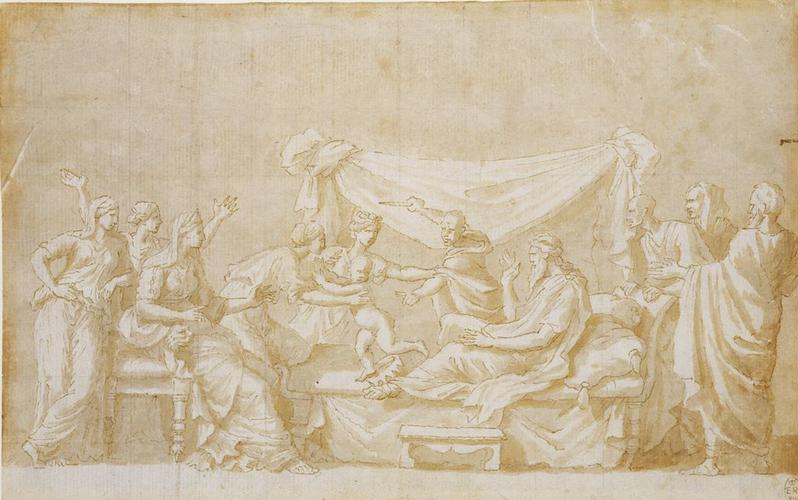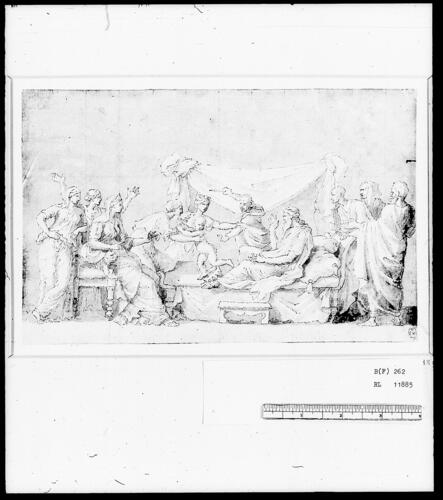-
1 of 253523 objects
The infant Moses trampling Pharaoh's crown c.1644-45
Slight black chalk underdrawing, pen and brown ink, pale brown wash, lightly squared in black chalk | 16.1 x 25.2 cm (sheet of paper) | RCIN 911885
-
A frieze-like drawing of Pharaoh on a couch, an infant trampling on his fallen crown; other figures around, one starting towards the infant with a knife. This episode is not recounted in the Old Testament, being derived instead from the Roman antiquary Flavius Josephus (Antiquitates, II, 9, 7): Moses was adopted by Pharaoh's daughter, who had found him in the bulrushes. At court, Pharaoh in jest placed his crown on the infant's head, who threw it down and trampled on it - a sign that he would one day overcome Pharaoh. Poussin painted two versions of this unusual subject, now in the Louvre and at Woburn Abbey. This drawing is close in its figuration to the Louvre painting and is squared for transfer, but some final adjustments were to be made: the line of heads is more varied in height in the painting, and the background and foreground are elaborated, negating the deliberate relief effect given here by the uniformly washed ground and the denial of any perspectival space.
The drawing has occasionally been described as a studio work, but there is no reason to doubt that it is an original drawing by Poussin, in the rather formal style he used throughout the 1640s in the latter stages of developing his compositions. His affliction of the trembling hand is in places pronounced, and his lack of confidence in the steadiness of his line may have caused him to make the short, stabbing strokes with which the figures are outlined.
The Louvre painting was executed for Camillo Massimi, who as a youth had received drawing lessons from Poussin, though the drawing is not from his collection, as many of the Poussin drawings at Windsor are. A sheet in the Gabinetto Nazionale in Rome (Rosenberg & Prat 1994, no. 290) has on its recto studies for the left-hand woman in Moses trampling Pharaoh's crown and the priest in its pendant painting, Aaron's rod changed into a serpent (also in the Louvre), and on its verso, in a uniform style, studies for Extreme Unction from the second set of Sacraments. A date around 1644-45 for the pair of paintings thus seems safe, coinciding with the rapid advancement of the young Massimi after the election of Giovanni Battista Pamphilj as Pope Innocent X in 1644. The two Louvre pictures must have been among his first major commissions. The Woburn Abbey version was painted for Jean Pointel, who was in Rome between April 1645 and July 1646; but Poussin presumably met Pointel in Paris, referring to him as a friend in a letter of March 1644, and that painting may have been commissioned and begun before Pointel's arrival in Rome.Provenance
Probably Cassiano dal Pozzo (1583-1657); from whose heirs bought by Pope Clement XI, 1703; passed to his nephew, Cardinal Alessandro Albani, 1714; from whom acquired by George III, 1762
-
Creator(s)
Acquirer(s)
-
Medium and techniques
Slight black chalk underdrawing, pen and brown ink, pale brown wash, lightly squared in black chalk
Measurements
16.1 x 25.2 cm (sheet of paper)
Object type(s)
Other number(s)
RL 11885

